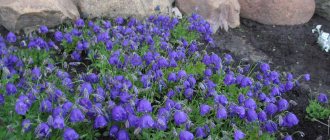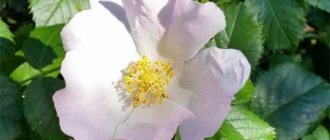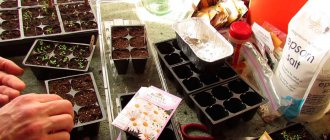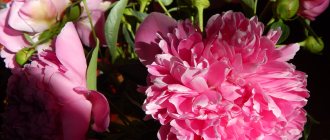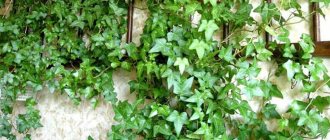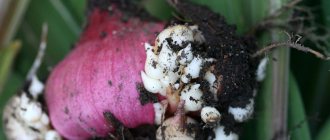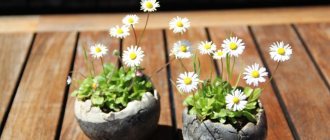The amazing shadberry plant is a shrub or small tree. The botanical name of the serviceberry is amelanchier. Canada is considered to be the birthplace of the plant; in the 16th century they learned about it in Europe. The plant grows in many regions, including Africa, America, Crimea, the Caucasus and the Far East. You can often see shadberry in the forest, bushes and mountains. It is believed that migratory birds that carried the seeds contributed to such a wide distribution of serviceberry. In Russia, in the 19th century, the famous botanist Ivan Vladimirovich Michurin began to grow shadberry.
The berries are very sweet, with a pleasant aftertaste, and are somewhat similar in appearance to currants. They need to be collected only when fully ripe, as they are much healthier that way. Irga perfectly satisfies hunger and strengthens the immune system. Not only berries are useful, but also leaves, seeds, and bark.
The name of the serviceberry varies among different nations; in Russia the popular names are sea buckthorn and wine berry; the Italians call it a willow delicacy, and the Germans call it a rock pear. Canadians gave the plant the name Canadian medlar.
Interesting Facts
- some varieties grow up to 18 meters;
- if you eat a kilogram of berries at once, you can fall asleep;
- dried berries are stored for up to 2 years;
- serviceberry is one of the most beautiful ornamental plants;
- According to scientists, the scientific name “amelanchier” is of Celtic origin, and the name “irga” is Mongolian and is translated as “a plant with very hard wood”;
- From a botanical point of view, the fruits of the plant are not berries at all, but small apples;
- In Canada, shadberry is grown mainly for winemaking.
general information
The shadberry plant, the photo of which is presented below, is found in almost the entire Northern Hemisphere. It grows in North Africa and America, and in the countries of the Far East, as well as in the Caucasus and Crimea. It can often be seen in forest clearings, as well as in the mountains among thickets of other bushes. Irga is a plant that thrives in any soil. The only place where it grows is swampy land where there is standing water. The main condition for normal fruit ripening is a sufficient amount of light. In such conditions, the fruits become large, juicy and healthy. This feature is inherent in all cultivated varieties of plants of the rose family, which includes serviceberry. Under normal agrotechnical conditions, the plant produces on average about fifteen kilograms of berries from each bush over the entire period of fruit ripening. In addition, they are incredibly healthy and are widely used in cooking.
Varieties and types
About 25 species of serviceberry are known, of which the most common are the following:
- round-leaved, shrub with ovoid leaves, grows up to 2.5 m. Blooms in May with white flowers. In July it bears fruit with blue-black berries with a bluish tint;
- ordinary, bush up to 3 meters in height, with a wide crown and thin branches. The flowers are pinkish, the berries are small, dark blue, with a white coating;
- Canadian, blooms profusely with white inflorescences. Grows up to 6 meters, produces large blue-black berries with a bloom;
- spiky, grows up to 6 meters, blooms in May with bright pink or white flowers with protruding pistils. Fruits with berries of a dark purple hue with a bluish bloom;
- blood-red, differs from other varieties in its ascending crown. Grows up to 3 meters. The berries are small, almost black;
- alder, a shrub with several trunks growing up to 4 meters in height. Flowering is white, berries are medium-sized, purple;
- Lamarck is distinguished by the beautiful color of its leaves in autumn, which acquire a dark red or yellow tint. The berries are dark purple in color, very sweet and juicy, and ripen in August. The plant can reach 18 meters in height, but in the Russian climate it does not grow higher than 5 meters;
- ballerina, gives dark red hearts, which gradually acquire a black tint. It grows up to 6 meters and is distinguished by bronze-colored leaves that gradually acquire a green tint.
Diseases
All types of crops are distinguished by good immunity to the main ailments that usually affect garden fruit plants. However, it should be considered a particularly dangerous disease.
Tubercularosis. Signs will be wilting of leaves and shoots, with the appearance of red growths on the surface. Treatment is carried out with Bordeaux mixture or treatment with copper sulfate. The affected aerial part must be cut off and burned.
Phyllostictosis spot. Signs will be brownish-brown spots on the green mass, which will begin to actively dry out. The fight against the disease is carried out by treating with Bordeaux mixture, with the removal of the affected parts.
Gray rot. The disease develops from an excess of moisture in the soil and manifests itself as brown spots on the green mass. Treatment is carried out by spraying with “Kuproksat” or “Topaz”.
Beneficial features
Irga is very rich in useful microelements and vitamins. 100 grams of berries contain 40 g of ascorbic acid. The berries contain pectin, flavonols, sugar, acids of organic origin, phytosterols and dietary fiber. The bark and leaves are rich in stearic and tannin substances. For the human body, irga is of great value due to its numerous properties:
- anti-inflammatory
- bactericidal
- tonic
- restorative
- cardiotonic
- astringent
- wound healing
- hypotensive
With regular consumption of berries, blood pressure noticeably decreases, the walls of blood vessels become more elastic and stronger. Irga has a good effect on the functioning of the cardiovascular system.
Irga is also useful as a prophylactic against:
- varicose veins
- myocardial infarction
- atherosclerosis
- vitamin deficiency
- stomach ulcers
- thrombosis
- cancerous tumors
- insomnia
- intestinal disorders
- sore throat
- diarrhea
Products made from berries help heal purulent wounds. Irga is a very powerful antioxidant and can cleanse the body of radionuclides and toxins. With constant consumption of berries, cholesterol decreases, appetite and gastrointestinal function improves. Riboflavin contained in shadberry improves vision and metabolism.
According to doctors, it is very useful for elderly people to consume shadberry. Vitamin P protects the body from many diseases characteristic of old age, starting from 60 years.
Berries are also very effective for weight loss. The calorie content is only 45 kcal per 100 g. They satisfy hunger well, and mixed with currant juice, serviceberry juice, when consumed correctly, allows you to get rid of 4 kg in a week.
Reproduction
You can get a new plant yourself in the following ways.
Seed method. Planting material is obtained from fully ripened fruits in summer or autumn. Sowing seeds in open ground is carried out immediately after collection, in pre-prepared beds. The material is buried 1.5-2 centimeters, watered abundantly, and covered with a layer of organic mulch. Shoots are expected next year in the spring; the seeds will undergo natural hardening in the soil, so only the most viable ones will hatch.
Subsequent care of seedlings concerns regular watering, removal of weeds and fertilizing with nitrogen-containing compounds. In the second or third year of life, the seedlings will be ready to be transplanted to a permanent place in the garden.
Method of grafting cuttings. You can use two-year-old rowan as a rootstock or choose any other option. The grafting of the cuttings is carried out in the spring, but before the sap begins to flow. The shoot is grafted at a height of 10-15 centimeters from the root collar of the plant.
Using a sharp knife, make a cut on the rootstock, about 30 mm deep. A wedge-shaped cut is made on the cutting at a distance of 10 centimeters from the top. A cutting is placed in the split and the joint is wrapped with tape.
The rootstock is planted in a box with peat and sand, deepening it to the grafting site. Further germination is carried out in greenhouse conditions, which significantly speeds up the survival rate of the cuttings.
When callus appears on the split, the tape will need to be removed and the seedling rooted in open ground.
Dividing the bush. The work is carried out in the spring, choosing an adult bush for propagation. It needs to be removed from the ground, the rhizome divided into several parts, each should have at least two strong shoots with a good root system. The cuttings can be immediately rooted in the garden in the chosen location.
Irgu can also be propagated by layering and green petioles.
Irga - recipes
In cooking, irga is widely used because of its taste and sweetness. Jams and jams are made from the berries, marshmallows, marmalade, compotes and juices are prepared. Berry puree is used for baking desserts. Berries and syrup from serviceberry go very well with ice cream, and they are used to prepare sauces for dishes. Infusions and wines made from berries, which have a piquant and special taste, are very popular.
Pests
Among the insect pests that pose a danger to shadberry:
- moth moth;
- irgovy seed eater.
Moth
Irgov seed eater
Destroy pests with “Karbofos” or “Fufanon”.
Decoctions and tea
Fruits, flowers, leaves and bark of serviceberry are widely used in folk medicine. They are used to prepare tea and decoctions that help restore the necessary level of microelements in the body, strengthen immunity and health.
Flower tincture is prepared using vodka. If you have an intolerance to this drink, you can use clean water. For 3 tablespoons of dried flowers you will need 2 cups of liquid. The flowers are infused in vodka for 3 days and then filtered. If the tincture is made of water, wrap the container, let it brew and filter. Drink 20 minutes before meals, 1 tablespoon, 3 times a day.
The juice of the berries is drunk fresh, diluted with water, or canned. It's very easy to prepare:
- dry the washed berries and turn into puree using a pestle;
- squeeze the juice out of the puree using a juicer or manually using gauze;
- dilute with currant or cherry juice, put on fire and heat without bringing to a boil. Roll the juice into jars while hot.
Drink 50-100 ml of juice before meals. The juice of more sour berries is diluted due to the strong sweetness of the serviceberry.
The tincture made from berries is very tasty, with a beautiful dark blue hue. It is prepared with vodka according to the following recipe:
- Grind the fruits into a puree with a pestle, fill the glass jar to ¾ and fill with vodka so that 4 cm remains from the neck;
- leave to brew for 3 days in a cool and dark place;
- Strain the tincture well, removing any remaining berries.
The drink is stored cold, take it three times a day before meals, 1 tablespoon.
Tea is prepared from fresh and dry leaves by pouring boiling water over them. Leave for 20 minutes and drink with a spoon of honey. Tea is also prepared from serviceberry flowers. It is good to drink this tea in the evening, it calms you down and ensures healthy sleep.
A decoction of the bark is used for external and internal use. Compresses from the decoction help treat wounds and burns. You can do it yourself:
- using a coffee grinder, grind the bark;
- Pour 2 tablespoons with 2 cups of boiling water;
- cook over low heat for 20 minutes, cool and strain;
- pour in a glass of boiled cool water.
The decoction is drunk 3-5 times a day, half a glass. For external use, the decoction is not diluted with water.
Flowering period
All species forms of serviceberry are distinguished by their neat appearance. Irga is a flowering plant that is attractive to insects. During the flowering period, it is covered with many buds. Depending on the variety, the color of the flowers can be not only pure white, but also pinkish. The buds are not arranged singly: they are arranged in delicate inflorescences.
Corinna blooms in spring. The excellent compatibility of serviceberry with other plants makes it possible to plant it in rows mixed with other shrub plants characterized by a summer flowering period. In this case, you can get a garden that will delight you with the beauty of colorful inflorescences, both in spring and summer. After the serviceberry has completely faded and sheds the petals of its fragrant inflorescences, the fluff from the leaves also disappears. And then it turns into an ordinary shrub with a well-developed stem part and a lush crown.
Storage
The fruits retain their beneficial properties and taste for a very long time, so many people stock up on irga for the winter. At room temperature, the berries can be stored for up to 3 days.
Drying irgi is carried out in a warm room with good ventilation. The fruits are laid out on a grid. You can use special dryers or ovens, stirring the berries regularly. The temperature should not exceed 60 degrees.
Frozen berries become even sweeter after defrosting and do not lose their shape. Irgu is frozen without adding syrup or sugar. It is important to carefully sort the fruits, wash them and dry them on a towel. The berries are scattered in one layer on a baking sheet or cardboard tray and placed in the freezer. Ready frozen fruits are stored in tightly tied bags.
Harvesting
The crop begins to bear fruit in the third year of life in open ground. The fruits do not ripen at the same time, so harvesting work can be carried out in several approaches. Ripe berries change color from light to dark. The collection is carried out in dry weather, from the end of May to July. On average, it will take about 90-100 frost-free days for the fruit to fully ripen. Their ripening continues even after separation from the bush.
Harvest in containers 15-20 centimeters deep; if there are a large number of berries, you should avoid deep buckets, as there is a risk of damage.
To preserve the nutritional value, it is recommended to store the harvested crop in a cool place.
How to plant and grow
Irga is an unpretentious plant that can withstand temperatures down to 40-50 degrees below zero. During the flowering period, the plant can withstand spring frosts down to -7 degrees. The irga sometimes lives up to 70 years and is rightfully considered a long-liver. Over the years, the bush turns into a tree.
You can plant shadberry anywhere; it grows well both in the sun and in the shade, and is not afraid of drought and wind. The plant takes root in any soil except swampy areas. The productivity and health of shadberry depends on the fertility of the soil. Landing is carried out in the following sequence:
- clear the area of weeds and dig up;
- dig a hole, mix the soil from it with compost and sand in a ratio of 3:1:1;
- add humus, phosphate and potassium fertilizer to the bottom of the hole;
- sprinkle the seedling with a mixture of soil, sand and compost, pour plenty of water;
- When the moisture is completely absorbed, add soil and level the hole to the surface. Mulch the top of the soil;
- trim the seedling so that there are no more than 4 buds on each shoot.
Seedlings for planting must be 1-2 years old. If you plant several bushes, it is preferable to do it in a checkerboard pattern; the distance between seedlings should be at least 1.5 meters.
Rules for planting seedlings
On your personal plot, it is best to plant a strong shoot, one to two years old. It must be healthy and have no visible damage. Before planting you need to consider:
- Season of the year. A favorable time for planting is early autumn, when there is no frost period.
- The distance between bushes should be at least 2 m.
- The landing site should be well lit.
- The soil must be moistened and fertilized.
A novice gardener can handle planting and caring for irga. During the work you will need: a shovel, a watering can with water, compost, drainage, sand.
Care
The shrub is unpretentious and does not require special attention, but it is, of course, worth devoting a little time to the shrub. The plant will thank you with a good harvest and healthy growth.
Necessary:
- Water the irgu regularly, but in reasonable quantities. The root system of the serviceberry is very developed, so special attention should be paid to watering during drought;
- It is useful to water with a sprayer, at the same time cleaning the leaves from dust;
- trim as necessary for visual appeal;
- carry out weeding.
Fertilize the plant after 5 years of life, once a year digging up the tree trunk circle with fertilizers.
Feeding mixture:
- bucket of humus
- 200 g of potassium fertilizers without chlorine
- 300 g superphosphate
It is useful to feed the plant with liquid organic matter in spring and until mid-summer. Chicken manure is suitable, diluted in water in a ratio of 1 to 10. One bush needs 5 liters of this solution.
It is recommended to feed the bush with liquid fertilizers in the evening, watering the plant first. After dry fertilizer with digging, the bush needs to be watered.
Trimming
For good fruiting, it is necessary to periodically trim old and weak branches. When to prune shadberry? Work should be carried out in early spring before bud break.
Old and weak branches, as well as the tops of a serviceberry tree or shrub, are eliminated. Pruning the crown is carried out to prevent branches from growing upward. Branches that thicken the bush are also eliminated.
Fruit
During the fruiting period, small berries with pink barrels can be seen on the currant. They are collected on one brush. The unripe fruits of most varieties of serviceberry are cream-colored, and as they ripen they acquire a violet or purple color. The berries have a pleasant taste. Their delicate sweetness and juiciness attract both young children and adults. Birds and irgis love to feast on the fruits, after which they spread the seeds of the plant throughout the area. Berries from the bush should be collected only when ripe, otherwise they will not have healing properties.
The fruit contains a huge amount of useful substances - dietary fiber (up to 25 percent), glucose and fructose, vitamins C, P, and group B, pectin and phytosterols, carotene, fiber, as well as various microelements.
